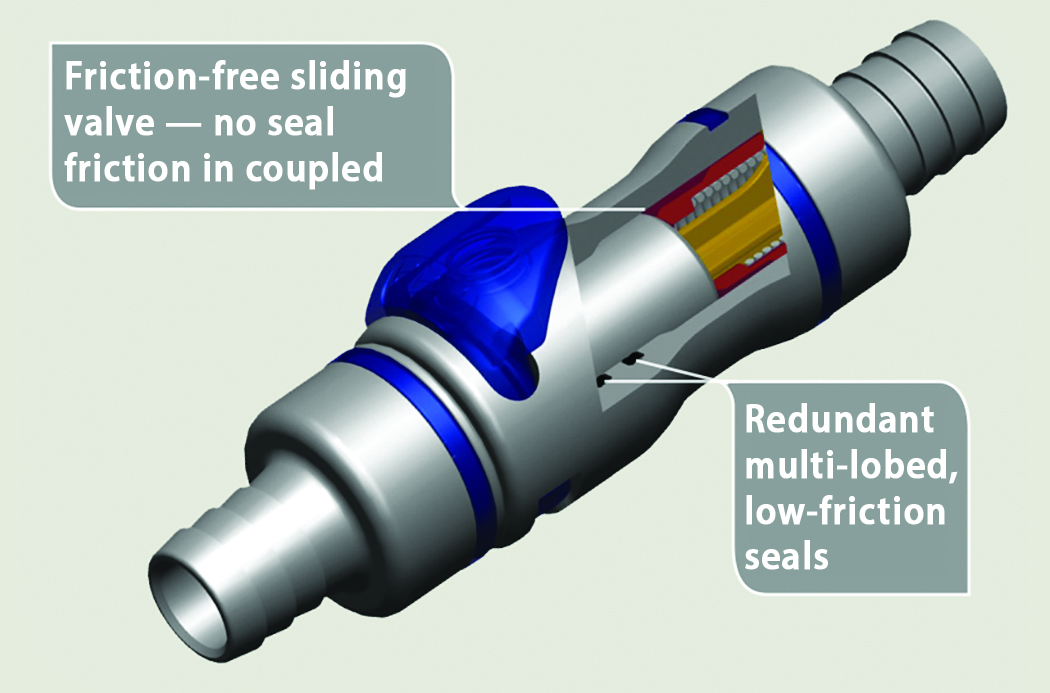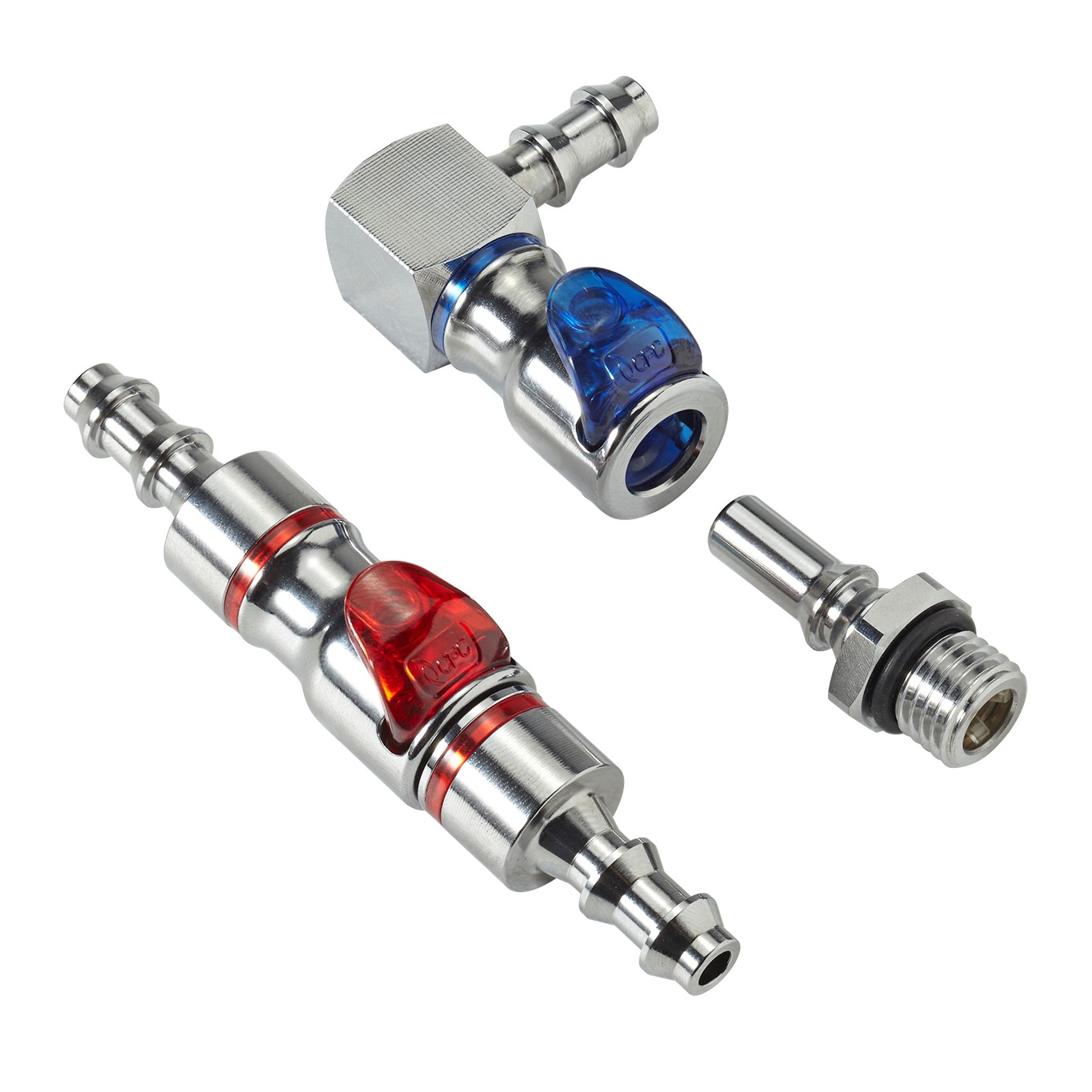BY DAVID VRANISH
Liquid Cooling Business Development Engineer, Colder Products Company
www.cpcworldwide.com
As data processing demands grow and densities increase, so do the challenges of removing heat effectively. Liquid cooling offers greater efficiencies than air-based systems, improves component life, and reduces operating costs for high-performance computers, medical lasers, MRI machines, power management equipment, projectors, radars, televisions, and more. However, concerns about mixing liquids and expensive electronics persist.
An effective solution to address those concerns are quick disconnects (QDs). QDs play an integral role to ensure reliable, leak-free cooling system performance. Given the wide range of uses for liquid cooling and the multiple QD options available today, a few key considerations help guide the selection of the right QD for specific applications.
Flow rates and pressure
QDs of the same size can deliver significantly different flow performance. For example, independent testing of a recently released 1/8-inch QD showed a 23% better flow rate (flow coefficient: CV = 0.37) than other currently available 1/8-inch connectors. This higher flow capacity reduces pressure drop through the connector by an average of 34%, minimizing the burden on cooling system pumps and optimizing performance.
When specifying the coupling, pressure drop across the connector must be factored in to understand the impact that the connector has on overall system performance. To calculate the pressure drop for a given flow rate through a QD, use the following equation:
Q = Cv √ΔP/S
Q = flow rate in gallons per minute
Cv = flow coefficient of the connector
ΔP = pressure drop in PSI (Δ between the upstream pressure and the downstream pressure)
S = specific gravity of fluid grams/cm^3
Considering the number of quick disconnects potentially used in a total system, this calculation and specifying decision significantly impact overall flow and efficiency.
Fluid media
To ensure reliability, it is essential to verify the chemical compatibility between coolants and QDs, which are available in many different materials. The connector’s housing, seals, and valves must withstand constant exposure to the cooling fluids without swelling, shrinking, corroding, or otherwise becoming distorted. Appropriate coolant selection and use also helps to avoid other issues that can impair cooling systems, such as degradation of nonmetallic components and biological growths or debris that obstruct fluid passages and valves.
Seals and valves
Non-spill QD couplings allow disconnection under pressure without drips or leaks — a critically important factor in protecting electronics from exposure to fluid and enabling hot swapping of equipment.
QDs used in liquid cooling applications stay connected for months or years at a time, but when disconnected, they must function flawlessly and without coolant drips. Some valve technologies are better suited for these situations. Look for QDs employing frictionless valves, which eliminate valve sticking due to seal compression set and keep connection forces low.
While many QDs employ O-rings, some connectors offer multi-lobed seals (see Fig. 1 ). Multi-lobed seals provide redundant protection against leakage, greater resistance to debris or foreign contaminants, and require less force to connect. Multi-lobed seals also retain their shape better than O-rings, which helps to maintain QD performance during extended periods of connection.
 Fig. 1: Double-sealed internal valves open upon connection and close upon disconnection for drip-free disconnections — critical for liquid cooling of electronics.
Fig. 1: Double-sealed internal valves open upon connection and close upon disconnection for drip-free disconnections — critical for liquid cooling of electronics.
Double-shutoff couplings use poppet valves that trap a small amount of liquid within the coupling body that can drip out when disconnected. While the leakage is likely just a drop or two, it might raise safety or reliability concerns around electronics. In contrast, true dry-disconnect couplings feature flush-face valves that allow no more than a coating of coolant on the valve surfaces, virtually eliminating the possibility of dripping onto vital components. High quality, precision-made, internal flush-face valves ensure secure, automatic closure upon disconnection, even after operating in the open position for months or years.
Metal, plastic — or both
Some liquid cooling systems use all-metal ball-and-sleeve couplings developed for the hydraulics industry. However, the seals and internal valves of these couplings were not designed for low-pressure/high-flow applications or ease of use.
Metal QDs remain popular because they are rugged and capable of tolerating rough handling. However, all-metal QDs are more susceptible to corrosion, and coolant-system maintenance is a must to facilitate lasting leak-free performance. When choosing a metal QD, be sure to select products specifically designed for liquid cooling applications.
QDs made from engineered polymers offer more than sufficient strength and durability in low-pressure (Adroit latch and joint designs simplify QD use
An older technology, ball-and-sleeve couplings are cumbersome to use, confusing for technicians to operate, and expensive. In contrast, cooling systems equipped with well-designed QDs make maintenance and servicing easier.
A seemingly small but significant advancement in QDs is the incorporation of ergonomically designed thumb latches for simple, intuitive, one-handed operation. A push of the thumb latch quickly connects or disconnects the QD. Other convenient and practical features available today include latches with an audible click, signaling a secure connection, and color-coded (see Fig. 2 ) parts to ensure accurate cold-side and return-side connections. Fig. 2: Non-spill QD features like swivel and elbow joints, color-coding, and thumb latches create fast, easy, and foolproof liquid cooling connections.
Fig. 2: Non-spill QD features like swivel and elbow joints, color-coding, and thumb latches create fast, easy, and foolproof liquid cooling connections.
Too often, the mounting configuration for connectors is an afterthought. With the wide variety of available mounting options — threads, in-line, rigid mount, panel mount, elbow — designers and engineers should select the most convenient mounting option for manufacturers and end-users alike. This is another area where all QDs are not equal. Some QDs now incorporate swivel joints and elbows to eliminate tube kinking and allow easier connection and disconnection, particularly in tight spaces.
Conclusion
Connections are a point of vulnerability in cooling systems if they do not function optimally. With the ability to select from multiple QD platforms and manufacturers, there is no reason to risk underperforming QDs that lead to drips, leaks, compromised flow, or hassles in connecting or disconnecting tubing. Conversely, high-quality, robust QDs allow users to connect cooling system components with speed and confidence.
QD suppliers that understand the demands of liquid cooling offer a wide selection of QDs, including purpose-built cooling couplings and custom design capabilities. Technology advancements around latching mechanisms, high-flow valves, and advanced materials offer significant advantages over older technology connectors, removing risk for cooling system designers while simplifying the ability to meet end-user requirements.
QDs purposely designed for liquid cooling applications enhance system usability, efficiency, and long-term, leak-free performance.
Advertisement
Learn more about CPC (Colder Products Company)





